AMADA's Natural Environment
Fujinomiya / AMADA’s Forest
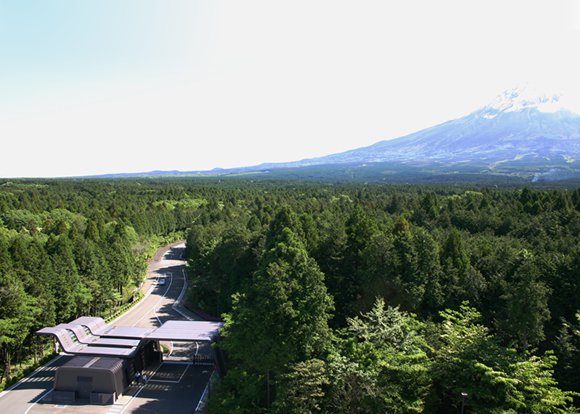
Approximately 60% of Fujinomiya Work's site, which is approximately 429,800m², remains as forests. And approximately 80% of them are artificial forests of “Japanese cypress.” Since it has been 40 to 50 years since the trees had been planted, we are planning to aggressively improve the forest into a forest rich in plants and animals.
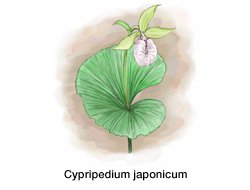
Approximately about 1100 pieces of plants and animals have been found on the Fujinomiya Works premises. When we re-organized the forest next to Factory #2, we found trees such as konara oak and Japanese snowbell, and also the plant Cypripedium japonicum designated as a category II (VU) endangered species by the Ministry of the Environment and Shizuoka Prefecture.
Isehara / Four Seasons Path
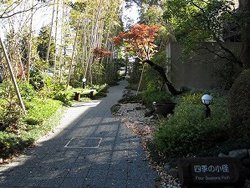
The bamboo grove along the headquarters building was redeveloped as “Four Seasons Path” for the employees to come and relax. Trees that wild birds and butterflies love are planted with good balance and please the eyes of everyone throughout the four seasons.
Green Infrastructure Initiative (Isehara Works/Fujinomiya Works)
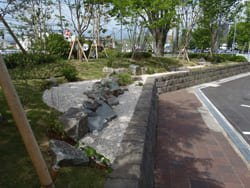
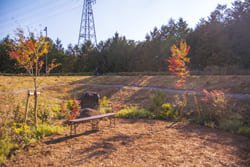
The AMADA Group is promoting the "Green Infrastructure" initiative, which is one of its efforts to preserve biodiversity and address climate change.
In November 2021, we added "Green Infrastructure" to the garden exterior on the south side of AMADA FORUM at the Isehara Works. Then, we reopened the garden as a "rain garden" equipped with a rainwater harvesting function*1.
In the spring of 2022, we also added a "rain garden" on the west side of West Block No. 3 Plant at the Fujinomiya Works. During heavy rainfall, the rain garden is effective in controlling rainwater runoff, purifying water quality, and funneling it into the soil, and at other times, it serves as a biodiversity-friendly green space for grassland ecosystems.
The rain garden initiative at the Fujinomiya Works received an Excellence Award in the "Disaster Prevention and Mitigation" category at the "3rd Green Infrastructure Awards" organized by the "Green Infrastructure Public-Private Partnership Platform", which is comprised of the national government, private companies, academic groups, and other organizations.
*1 Green infrastructure refers to an initiative to promote the development of sustainable and attractive land, cities, and regions using the diverse functions of the natural environment. A rain garden is a type of green infrastructure that is designed to collect and clean rainwater while allowing it to slowly seep into the ground. In addition to mitigating the load on drainage pipes during heavy rains, preventing the flooding of sidewalks and driveways, and improving water quality, it also offers beautiful scenery as a garden made with white gravel, masonry, and plants.
Greenery Factory (Fujinomiya Works)
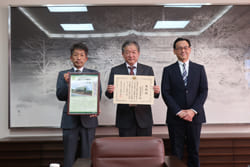
The AMADA Fujinomiya Works received the Director-General's Award of Kanto Bureau of Economy, Trade, and Industry for Excellent plant Greening in FY2021. The purpose of this award program is to further promote factory greening by recognizing factories that proactively promote factory greening and have made remarkable improvements to the environment inside and outside their sites, following the spirits of the Factory Location Act.
At AMADA, both Isehara and Fujinomiya Works received at the same time the "Japan Greenery Research and Development Center Chairman's Award" in FY2016, and the Isehara Works received the "Kanto Bureau of Economy, Trade, and Industry Director-General's Award" in FY2019.
Isehara / Rooftop garden
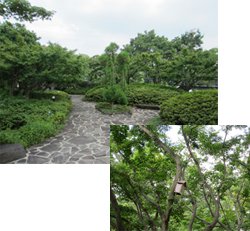
The rooftop garden near the Isehara Works main building was created about 35 years ago.
It started with a handful of trees, but there are now several dozen.
A variety of birds can be seen in the garden, and great tits have been noted in the nesting boxes there.
Toki Works / The Biotope
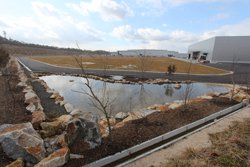
The biotope at the Toki Works was designed to facilitate the effective use of onsite spring water, and also as a small reservoir for irrigating plants. It covers an area of 200m2 and holds approximately 100 tonnes of water.
The pond is heart-shaped when seen from the above. Local granite known as mino kurama are used around the edges of the pond.
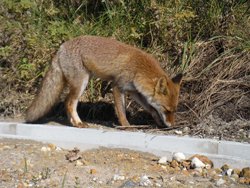
Water, greenery and stones come together in harmony at the biotope, which also serves as an oasis for the company employees. Even foxes make occasional visits here.
Contact for repair/recovery of AMADA products and our corporate activities.